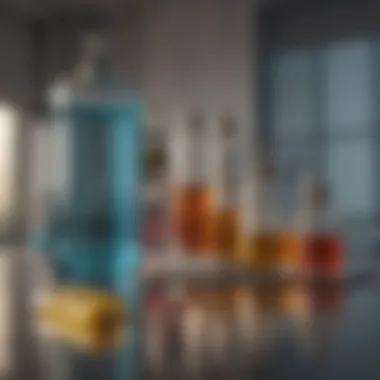Disinfectants vs. Sanitizers: Key Differences Explained


Intro
Understanding the cleaning agents we use in our homes and workplaces is crucial for maintaining hygiene. Recently, the terms disinfectants and sanitizers have become more prominent in discussions about cleanliness. However, many people do not fully grasp the distinctions between these two types of products. This article aims to clarify these differences in depth.
Understanding these distinctions is not only relevant for personal hygiene but also holds significance in healthcare, food service, and various industries. Choosing the right product can vastly influence cleanliness levels, particularly in environments where pathogens thrive.
We will explore definitions, specific uses, chemical compositions, and their effectiveness in reducing pathogens. This analysis aims to equip readers with informed choices regarding the right cleaning products for different situations.
Foreword to Cleaning Agents
Cleaning agents play a pivotal role in maintaining hygiene and cleanliness in our daily lives. As we navigate various environments, understanding the differences between these agents is essential. Specifically, disinfectants and sanitizers are key players in the battle against pathogens. This section will focus on the importance, benefits, and considerations surrounding cleaning agents.
Cleaning agents are formulated to eliminate dirt, stains, and germs. They are often the first line of defense in both residential and commercial settings. The efficacy of these agents can greatly influence health outcomes, making it essential for individuals and organizations to make informed choices. The consequences of poor hygiene practices can lead to the spread of illness, impacting both human health and overall safety.
Moreover, cleaning agents encompass a variety of products, but not all are created equal. Disinfectants and sanitizers serve distinct purposes in the realm of hygiene. Disinfectants typically target a broad range of pathogens and are essential in high-risk environments. Sanitizers, on the other hand, reduce the number of germs to safe levels but do not necessarily eliminate all pathogens. Thus, understanding their specific roles and applications is critical for effective hygiene management.
Definitions of Disinfectants and Sanitizers
Understanding the definitions of disinfectants and sanitizers is essential because these terms are often used interchangeably, however, they refer to different actions and applications. Recognizing these differences can lead to better hygiene practices, particularly in settings where pathogen reduction is crucial. With an increasing focus on cleanliness in public and private spaces, this distinction becomes even more critical.
What is a Disinfectant?
Chemical Composition
Disinfectants are substances designed to kill a wide range of microorganisms, including bacteria and viruses. Their chemical composition typically includes active ingredients such as chlorine, hydrogen peroxide, or quaternary ammonium compounds. These components can create a hostile environment for pathogens, effectively neutralizing them. For instance, hydrogen peroxide is popular due to its ability to break down into harmless water and oxygen post-use, mitigating any risks associated with residue.
Common Disinfectants
Common disinfectants include products like Clorox Bleach, Lysol Disinfectant Spray, and Purell Advanced Hand Sanitizer. Each of these products contains active ingredients that serve to eliminate germs on surfaces. The effectiveness of these disinfectants can vary based on factors like concentration, contact time, and the specific pathogens being targeted. For example, Clorox Bleach is known for its broad-spectrum efficacy, making it a strong choice for environments such as hospitals or kitchens. However, it can be harsh on surfaces and skin, limiting its use in certain applications.
What is a Sanitizer?
Chemical Composition
Sanitizers, in contrast, are formulated to reduce the number of microorganisms to safe levels as described by public health standards. The primary active ingredients in many sanitizers are alcohols, such as ethanol or isopropyl alcohol. These compounds work by disrupting cellular processes in bacteria and viruses, effectively reducing their numbers. Alcohol-based sanitizers are favored for their rapid evaporation rate, which allows for quick application without extensive drying times.
Common Sanitizers
Common sanitizers include brands like Purell Hand Sanitizer and Germ-X Hand Sanitizer. These products are widely used in both personal and public spaces due to their ability to quickly eliminate germs on hands and surfaces. The unique feature of alcohol-based sanitizers is their convenience and speed of action. However, they are less effective against certain pathogens, such as Norovirus, which can limit their utility in specific situations. Also, user practices, such as applying an insufficient amount, can affect the efficacy of these products.
Mechanisms of Action
Understanding how disinfectants and sanitizers act is crucial for discerning their appropriate uses and effectiveness. The mechanisms behind their action can significantly influence the choice between them in various settings. The way each type interacts with pathogens can alter the approach needed in maintaining hygiene. This section elucidates the two main types of cleaning agents' mechanisms, highlighting their methods, strengths, and notable environmental considerations.
How Disinfectants Work
Targeting Bacteria and Viruses
Disinfectants perform their function by actively targeting bacteria and viruses. The key characteristic here is their ability to destroy or inactivate pathogens on surfaces, making them effective against a broad spectrum of germs. The contribution of this mechanism to overall hygiene is central; by eliminating microorganisms, disinfectants can provide a safer environment especially in high-risk areas such as hospitals and kitchens.
What sets this aspect apart is the concentration of the active ingredients in disinfectants, which is often higher than those found in sanitizers. This feature allows them to tackle resilient pathogens but can also lead to concerns regarding residue or toxicity if not used properly. Moreover, the need for appropriate contact time adds a layer of complexity to their application, ensuring effectiveness through adherence to manufacturer's guidelines.
Environmental Considerations
Environmental considerations are fundamental when discussing disinfectants. Many products today aim to strike a balance between efficacy and safety for human health and the environment. A key characteristic of this topic is the increasing trend toward eco-friendly formulations. Such products not only serve to disinfect surfaces but also minimize harmful effects on ecosystems.
This unique feature of considering the environmental impact serves as an advantage. Adopting sustainable cleaning products can significantly reduce chemical runoff into water systems. However, there are also disadvantages. Some eco-friendly disinfectants may not be as effective as traditional chemical-based ones, potentially leading to a trade-off in cleaning efficacy.
How Sanitizers Work


Surface Interaction
Sanitizers function through surface interaction, which is their defining characteristic. They work by reducing the number of microorganisms on surfaces to safe levels, rather than eliminating them entirely like disinfectants do. This mechanism is particularly beneficial in environments where cleanliness is crucial but complete sterilization is not practical, such as in food service or low-risk health care settings.
An advantage of this approach is the quick reduction of pathogens, allowing for fast turnover in cleaning processes. Disadvantages include the fact that sanitizers may not effectively handle resistant strains of bacteria or viruses, making their use limited in high-risk areas.
Rapid Action Features
Rapid action features are a distinct aspect of sanitizers. They are designed to work quickly, providing immediate effects on pathogens. This is a significant benefit, especially in busy environments where time is of the essence. Key to their appeal is the convenience of use; many sanitizers require minimal dwell time, allowing for quick cleaning without long interruptions. However, such rapid action may come at a cost. The swift killing effect does not guarantee a long-lasting presence or residual protection against the recontamination of surfaces, which may necessitate more frequent applications. Users should be aware that while sanitizers provide quick results, continued vigilance is important to maintain hygiene effectively.
Efficacy and Application
Understanding the efficacy and application of disinfectants and sanitizers is crucial for making informed decisions about hygiene practices. This section highlights how each product reduces pathogens and the contexts in which they are most effective. Choosing the right agent has implications for health, safety, and environmental considerations, especially in commercial and residential settings.
Efficacy of Disinfectants
Broad Spectrum vs. Narrow Spectrum
The broad spectrum and narrow spectrum classification of disinfectants defines their effectiveness against various microorganisms. Broad spectrum disinfectants can eliminate a wide range of pathogens, including bacteria, viruses, and fungi. This characteristic makes them very popular in settings like hospitals, where the risk of infection is high. For instance, products containing sodium hypochlorite can kill multiple types of bacteria and viruses, making them essential in preventing hospital-acquired infections.
On the other hand, narrow spectrum disinfectants target specific microorganisms. While they can be effective in particular situations, they may not offer comprehensive protection against all pathogens. This limitation can be a disadvantage in environments that require a higher level of disinfection. However, they tend to be less harsh on surfaces, which can make them attractive for regular cleaning in homes.
Therefore, broad spectrum disinfectants are beneficial in high-risk areas, while narrow spectrum types find their place in routine maintenance.
Residue and Surface Durability
Residue and surface durability are essential concepts when considering the application of disinfectants. Some disinfectants leave a residue on surfaces after application. This property can influence how safe and clean a surface is deemed subsequently. For example, a disinfectant that leaves behind a protective barrier can maintain surface integrity and provide ongoing protection against new contaminants. However, this residue must be safe for human and pet contact.
Conversely, some disinfectants evaporate quickly, leaving little to no residue. This can be beneficial in environments like kitchens, where food safety is paramount. But without residue, the effectiveness may diminish over time since no ongoing protection is provided against pathogens.
In summary, understanding whether a product leaves behind residue can shape its overall usefulness and impact on surface safety.
Efficacy of Sanitizers
Surface Safety Standards
Surface safety standards are critical in assessing the effectiveness of sanitizers. These standards determine how well a sanitizer can reduce microbial presence on surfaces to safe levels. For instance, the US Environmental Protection Agency (EPA) has established guidelines that sanitizers must meet to be labeled as effective. These standards often require a 99.9% reduction of specific pathogens on surfaces.
Sanitizers that adhere to surface safety standards are particularly useful in non-clinical settings, such as food preparation areas. Their ability to quickly reduce bacterial loads makes them favorable for daily cleaning without compromising food safety.
The key characteristic of adhering to these standards is compliance and ensures a level of safety for both users and surfaces. Quite often, meeting these guidelines is a sign of effectiveness and consumer trust.
Limitations of Sanitizers
While sanitizers are effective in many scenarios, their limitations warrant careful consideration. Sanitizers focus on reducing microorganisms rather than eliminating them entirely, which can be a drawback in high-contamination environments. For example, when used on heavily soiled surfaces, sanitizers may not perform well as dirt can impede their action. This limitation may force users to implement more thorough cleaning routines prior to sanitizing, thereby increasing time and labor.
Additionally, certain pathogens may require specific treatments beyond what standard sanitizers can offer. Therefore, it is vital to understand the environments in which sanitizers are most effective and when stronger disinfectants may be necessary. This understanding highlights the importance of selecting the right cleaning agent according to specific needs.
"Choosing the right cleaning agent can significantly influence the safety and hygiene of an environment."
With this knowledge, stakeholders can make informed choices to enhance cleanliness and health in their spaces.
Regulatory Standards and Safety
Understanding regulatory standards in disinfectants and sanitizers is essential. These regulations ensure that the products we use to maintain cleanliness meet specific safety and effectiveness guidelines. For both disinfectants and sanitizers, regulations are enforced primarily by agencies such as the FDA and EPA. This oversight helps consumers make informed decisions when selecting cleaning agents.
Regulatory Overview for Disinfectants


FDA and EPA Guidelines
The FDA and EPA Guidelines play a crucial role in defining how disinfectants are developed, tested, and used. These guidelines ensure that disinfectants are proven effective against pathogens, which is vital for public health. A key characteristic of these guidelines is their comprehensive reviews of chemical compounds before they can be marketed.
One of the benefits of adhering to these guidelines is increased trust from consumers. When a product meets EPA approval, it signals that the disinfectant has undergone rigorous testing. However, a disadvantage can arise from the length of time required for approval, potentially delaying market readiness of effective products.
Labeling and Usage Instructions
Labeling and Usage Instructions are critical for guiding consumers in the correct application of disinfectants. Proper labeling is not merely a suggestion; it is mandated by regulations to ensure safe and effective use. This includes specifying concentration levels and contact times necessary for effective pathogen elimination.
A key characteristic of labeling is clarity. Clear usage instructions are beneficial as they help minimize mistakes in application. However, a unique challenge can arise here; if labels are too technical, consumers may not understand them. This can lead to ineffectiveness when cleaning.
Regulatory Overview for Sanitizers
Compliance Standards
Compliance Standards for sanitizers involve similar regulatory oversight as disinfectants. These standards focus on the acceptable efficacy levels of sanitizers to ensure safety for consumers. Compliance ensures that sanitizers effectively reduce bacteria and viruses on surfaces. A noteworthy feature is that sanitizers must meet specific criteria to be labeled as such, which indicates their intended use is to reduce, rather than completely eliminate, pathogens.
The benefit of these compliance standards is enhanced safety in environments where sanitizers are used. Nonetheless, this can lead to confusion as many consumers may assume all sanitizers provide complete protection.
Safety Concerns
Safety Concerns regarding sanitizers focus on potential health risks related to their components. Ingredients can vary widely, and some may pose risks if used improperly. One prominent characteristic of safety regulations is that they require manufacturers to disclose all ingredients on labeling, aiding consumers in making informed choices.
The advantage of addressing safety concerns head-on is heightened consumer awareness and accountability. Yet, a unique challenge is the tendency for consumers to overlook these warnings, which can result in misuse.
Proper understanding of these regulatory standards is crucial for choosing the right cleaning agents to ensure both efficacy and safety in maintaining hygiene.
Choosing the Right Agent
Choosing the right cleaning agent is essential for maintaining hygiene and ensuring safety in various settings. Disinfectants and sanitizers serve different roles. Understanding when to use each can make a significant difference in effectiveness. Selecting the appropriate cleaner influences outcomes such as pathogen reduction and surface safety. Moreover, knowing the distinctions helps in optimizing resources and avoiding ineffective practices that could lead to health risks.
When to Use Disinfectants
High-Risk Environments
High-risk environments include areas such as hospitals, kitchens, and public restrooms. These spaces are prone to bacterial and viral infections due to high foot traffic and close contact among individuals. A key characteristic of high-risk environments is the presence of vulnerable populations, such as the elderly or immunocompromised individuals. In these contexts, disinfectants are a beneficial choice because they are designed to eliminate pathogens on surfaces effectively.
The unique feature of using disinfectants in high-risk environments is their ability to destroy a wide range of microorganisms, including resistant strains. This broad-spectrum efficacy presents clear advantages, but also some disadvantages, such as potential surface damage if misused. It is essential to follow guidelines specific to these areas to maximize effectiveness without compromising safety.
Protocols for Effective Disinfection
Protocols for effective disinfection are systematic procedures designed to ensure thorough cleaning and pathogen elimination. A key characteristic of these protocols is their structured approach, which includes steps like pre-cleaning, using the right disinfectant, and allowing adequate contact time. This methodical process enhances the overall effectiveness of disinfection efforts, making it a popular choice in varied settings.
The advantage of having established protocols is that they guide users during the disinfection process, reducing the likelihood of errors. However, one disadvantage is that they require proper training to implement effectively. Skipping steps or rushing the process can diminish results, which underscores the importance of adherence to these guidelines in achieving the intended sanitization outcome.
When to Use Sanitizers
Low-Risk Environments
Low-risk environments, such as homes, offices, and gyms, generally have fewer pathogens present, making sanitizers an appropriate choice. These settings typically involve less communal use of surfaces, leading to a lower potential for infection transmission. The key characteristic of low-risk environments is that they often only require a reduction of pathogens rather than complete elimination. Thus, sanitizers can effectively address this need.
A unique feature of sanitizers is their ability to work swiftly, often requiring minimal contact time. This rapid action is beneficial as it allows for quick turnaround in environments where cleanliness is essential but high-level disinfection may not be necessary. However, one downside is that sanitizers do not eliminate all pathogens, particularly spores, which could be a concern in specific scenarios.
Practical Application Tips


Practical application tips for using sanitizers can significantly improve their effectiveness. A key aspect of these tips includes recommendations for surface preparation and appropriate sanitizer selection based on explicit use cases. This guides users in maximizing the efficacy of sanitizers during everyday cleaning tasks.
The value of practical tips lies in their simplicity and accessibility, making sanitizing strategies easy to adopt for everyone. However, a notable disadvantage is the misconception that sanitizers can substitute for thorough cleaning. It is vital to clarify that while sanitizers enhance hygiene, they do not replace the fundamental need for regular cleaning practices, especially in environments where hygiene concerns are pronounced.
Clarifying Common Misconceptions
Understanding disinfectants and sanitizers is essential for proper hygiene practices. Many people confuse these terms, which can lead to ineffective cleaning approaches. The goal of this section is to address these misunderstandings. By clarifying misconceptions, individuals can make informed decisions related to cleaning agents. This knowledge is especially important in settings where hygiene is crucial, such as homes, schools, and healthcare facilities.
Misunderstandings About Disinfectants
Disinfectant vs. Cleaner
A common misconception is viewing disinfectants and cleaners as interchangeable. A cleaner mainly refers to products that remove dirt and grime. These may contain surfactants that help lift away soil from surfaces. However, a disinfectant is specifically designed to kill microorganisms. This distinction is vital because only disinfectants can ensure surfaces are not just clean but also free of pathogens.
Using disinfectants where cleaners are needed may not adequately address dirt, while using cleaners in place of disinfectants does not ensure microbial safety.
Key Characteristics: The primary characteristic of a disinfectant is its effectiveness against germs. Cleaners may not contain ingredients that destroy pathogens. Therefore, recognizing when to use each can prevent health risks.
Advantages: The advantage of disinfectants in this article is clearly depicted. They play a crucial role in sanitized environments where pathogen spread is a concern. For instance, during outbreaks of illness, understanding the difference improves effectiveness in infection control.
Effectiveness Myths
Another notable misconception revolves around the effectiveness of disinfectants. Many believe that just applying a disinfectant guarantees pathogen elimination. This is not entirely true. The effectiveness of a disinfectant can vary based on factors such as concentration, contact time, and type of microorganism.
Key Characteristic: The essential characteristic here is the importance of following manufacturer instructions. Disinfectants often need a specific contact time to be effective. Rushing the process may lead to inadequate killing of germs.
Advantages: Recognizing effectiveness myths not only ensures proper use but also optimizes cleaning procedures. By understanding and addressing these misconceptions, individuals can enhance overall sanitation practices in their environments.
Misunderstandings About Sanitizers
Sanitizing vs. Sterilizing
There is a significant misunderstanding around two terms: sanitizing and sterilizing. Sanitizing reduces the number of bacteria, while sterilizing aims for total destruction of all microorganisms. This distinction is critical in understanding suitable cleaning methods across various settings.
Key Characteristic: When using sanitizers, it’s essential to note that they are often designed for environments that don’t require complete sterility. This means sanitizing is adequate for places like kitchens or bathrooms, where health safety is still a priority.
Advantages: By understanding this difference, consumers can choose the right product for their specific needs. In situations like commercial kitchens, where the risk of foodborne illness exists, knowing when to sanitize versus sterilize can have direct implications for health and safety.
Common Sanitation Errors
Many people make errors in their sanitation practices. It often happens when sanitizers are misapplied, such as not allowing surfaces to air dry after application. This can lead to reduced effectiveness, as moisture can hinder the action of the sanitizer.
Key Characteristic: One key characteristic of proper sanitation is following instructions on product labels. Ensuring a surface is clean before applying sanitizer also affects its success rate in reducing germs.
Advantages: Acknowledging common sanitation errors allows individuals to refine their cleaning processes. It equips them to utilize sanitizers efficiently, ensuring that microbial hazards are minimized in their spaces.
Culmination
In this article, we explored the vital distinctions between disinfectants and sanitizers, emphasizing their unique roles in the realm of cleanliness and hygiene. Understanding these differences is crucial for selecting the right cleaning agent suited for specific needs. Improper use of these products can lead to inadequate pathogen control, which can have serious health implications.
Summary of Key Differences
To summarize, disinfectants and sanitizers, while both aimed at improving hygiene, operate in fundamentally different ways. Disinfectants are more potent, targeting a broader spectrum of pathogens, and are essential in high-risk environments such as hospitals and clinics. Their chemical compositions often include bleach and alcohol, which are designed for serious disinfection tasks. In contrast, sanitizers are effective against fewer organisms while allowing for quicker application and surface safety, suited for everyday use in settings like kitchens and bathrooms.
- Disinfectants:
- Sanitizers:
- More effective at killing a wider range of pathogens
- Generally require longer contact times
- Commonly used in high-risk scenarios
- More suited for routine cleaning
- Kill fewer pathogens but with faster application
- Useful in low-risk areas
Final Thoughts on Usage
As we conclude, it is crucial to choose wisely between disinfectants and sanitizers based on the environment and the level of contamination present. Using disinfectants inappropriately can lead to issues such as skin irritation or damage to surfaces, whereas relying solely on sanitizers in high-risk settings may not provide adequate protection against pathogens.
Prioritize effectiveness, safety, and proper application techniques when considering these cleaning agents. By understanding these nuances, one can maintain elevated hygiene standards effectively and responsibly, ensuring a healthier environment for all.







